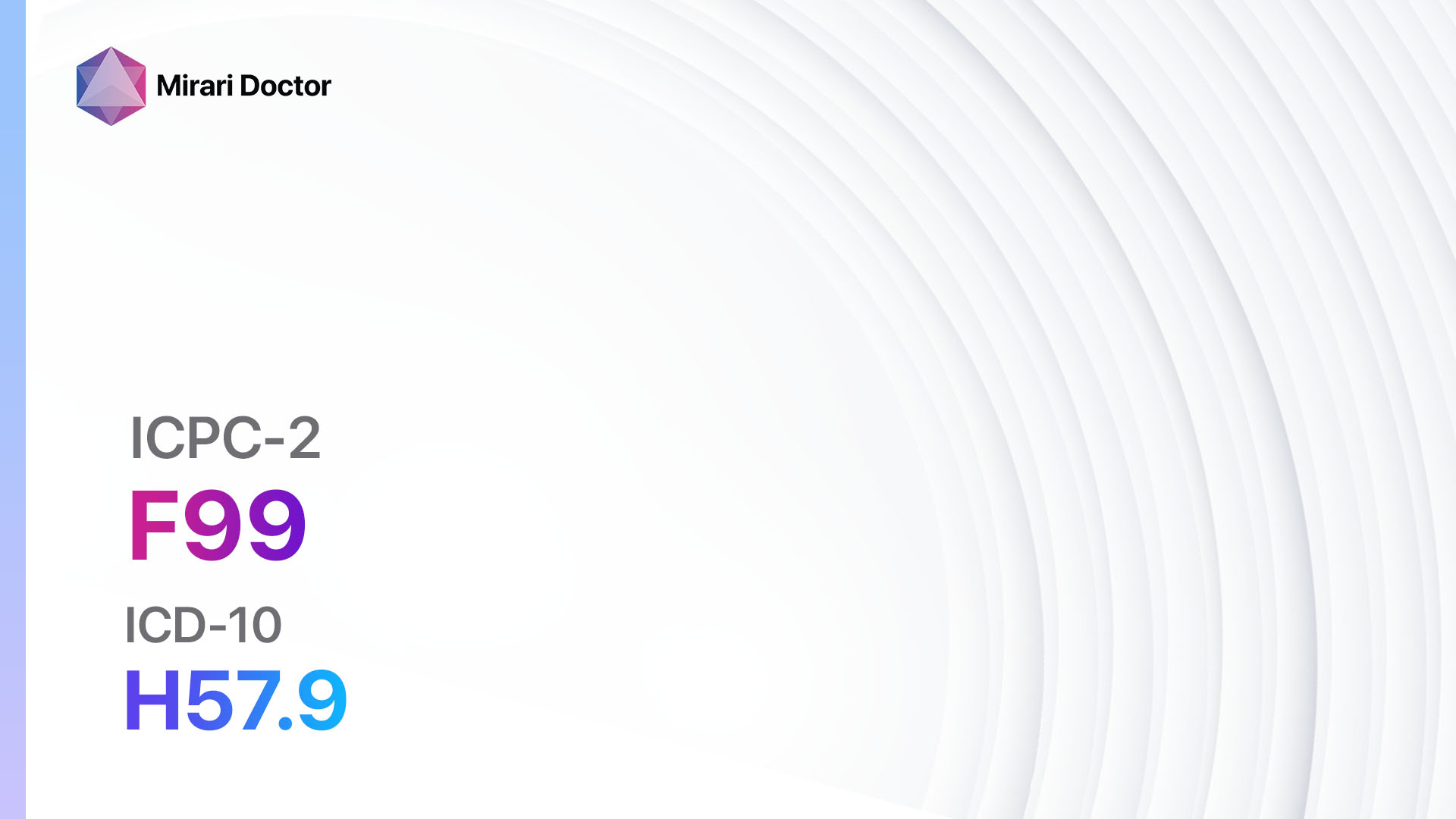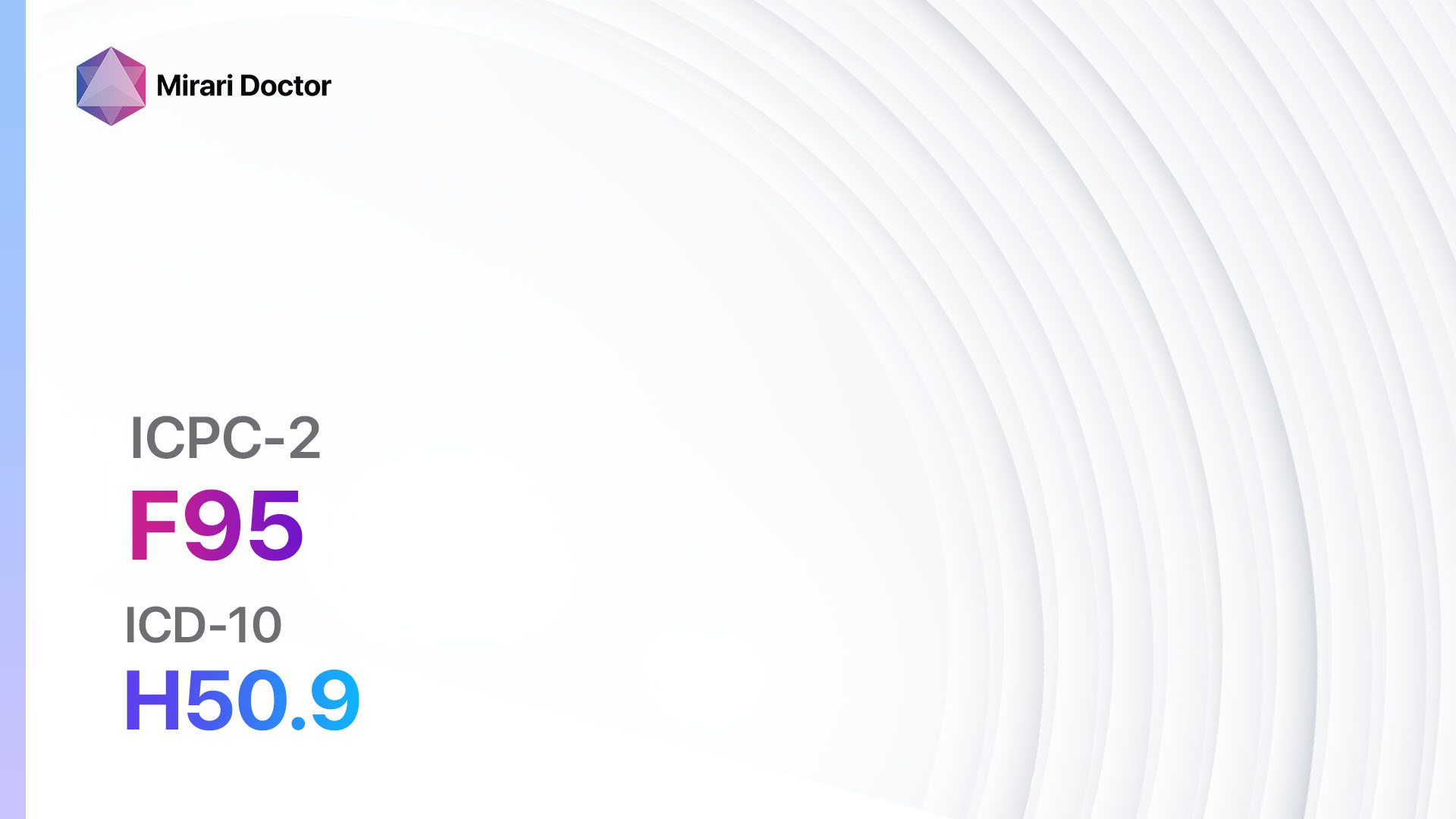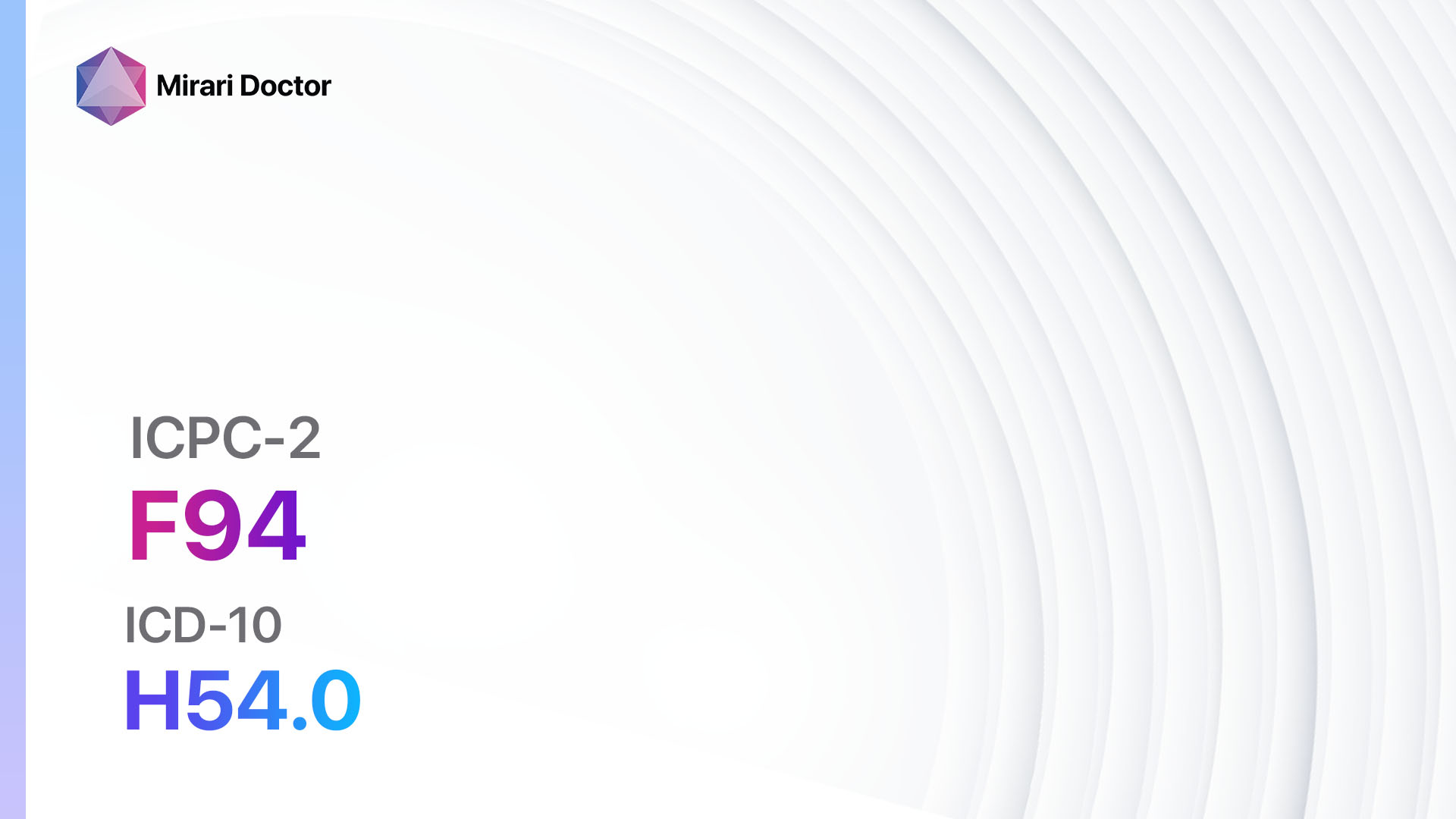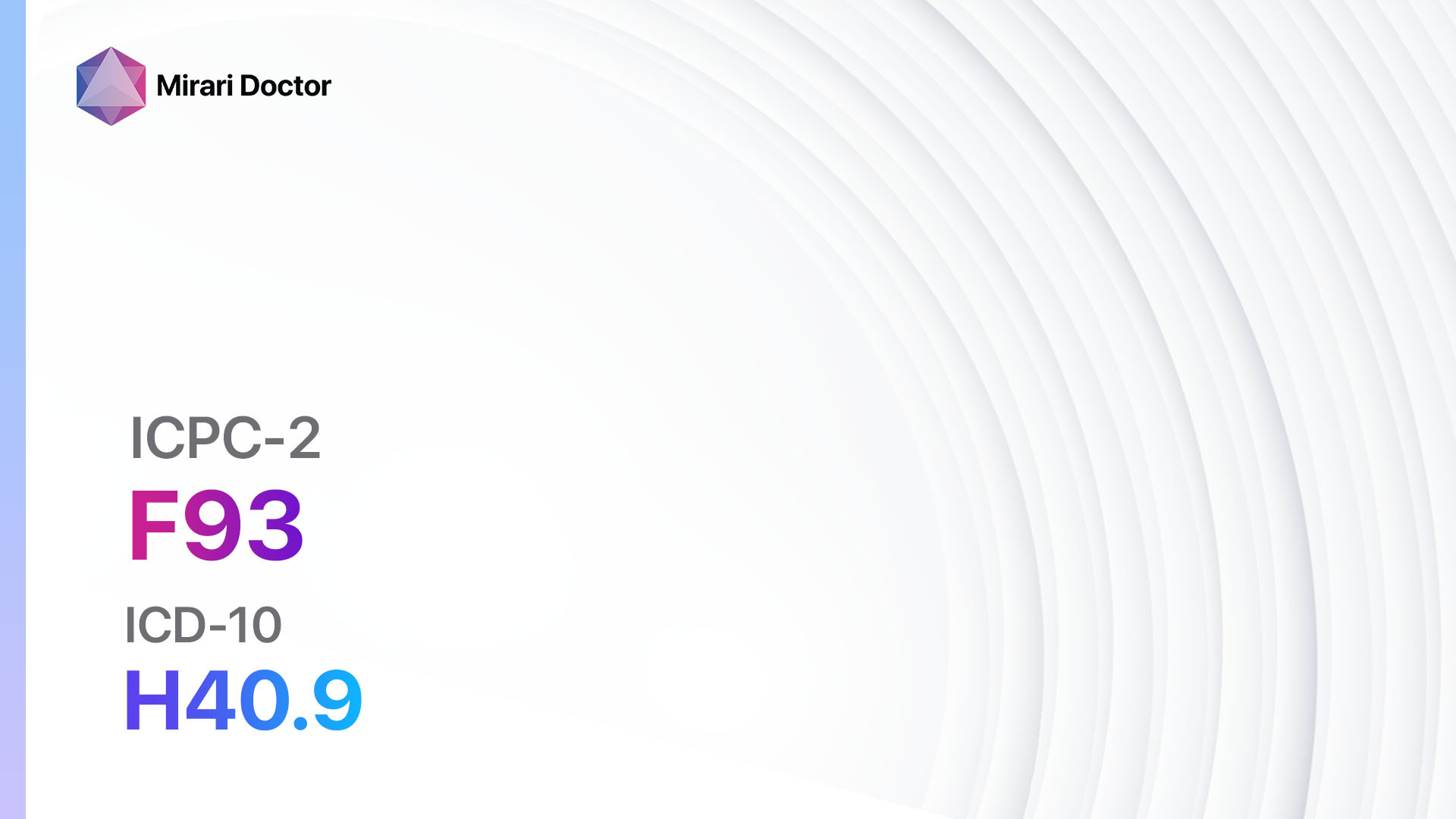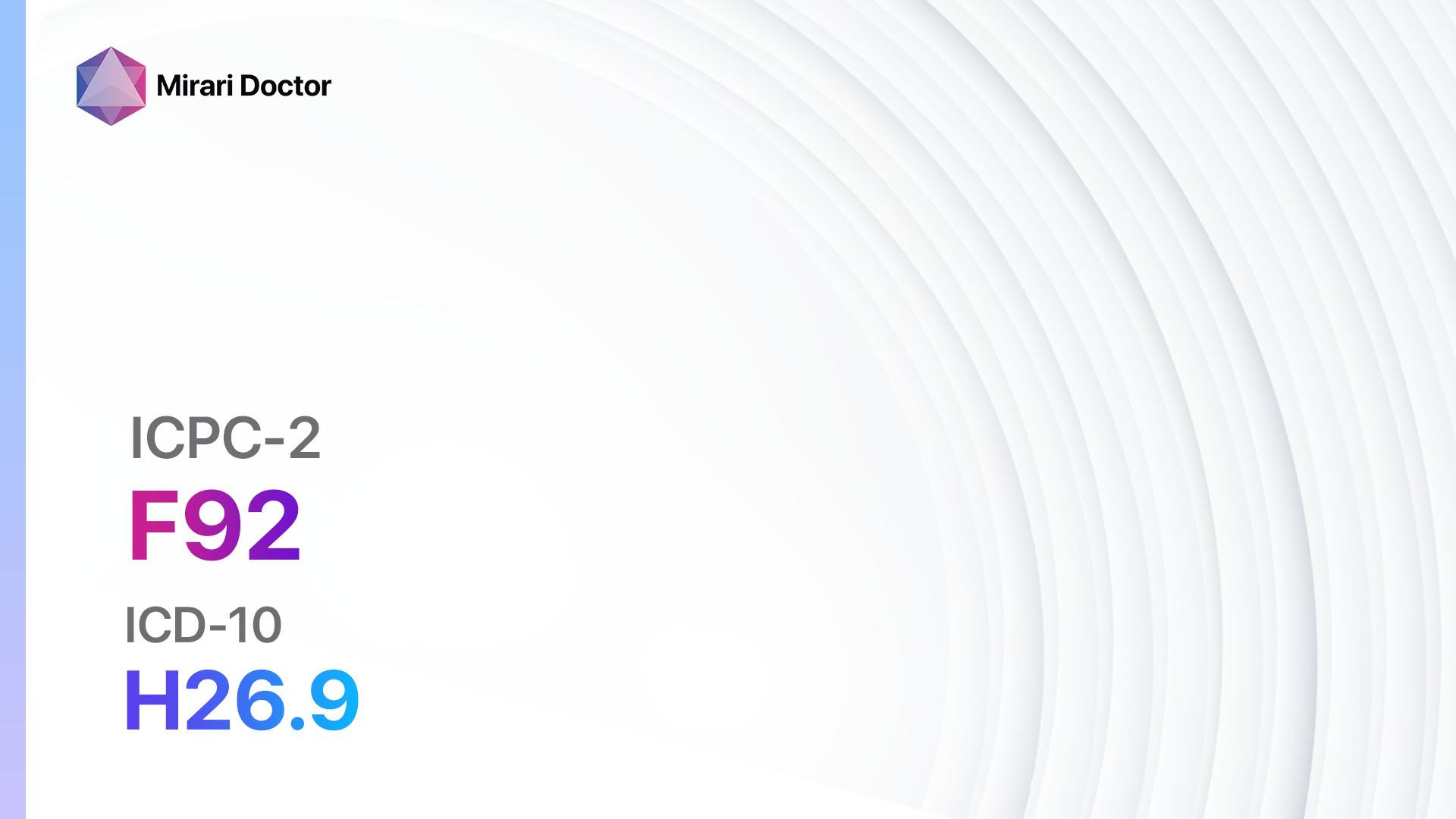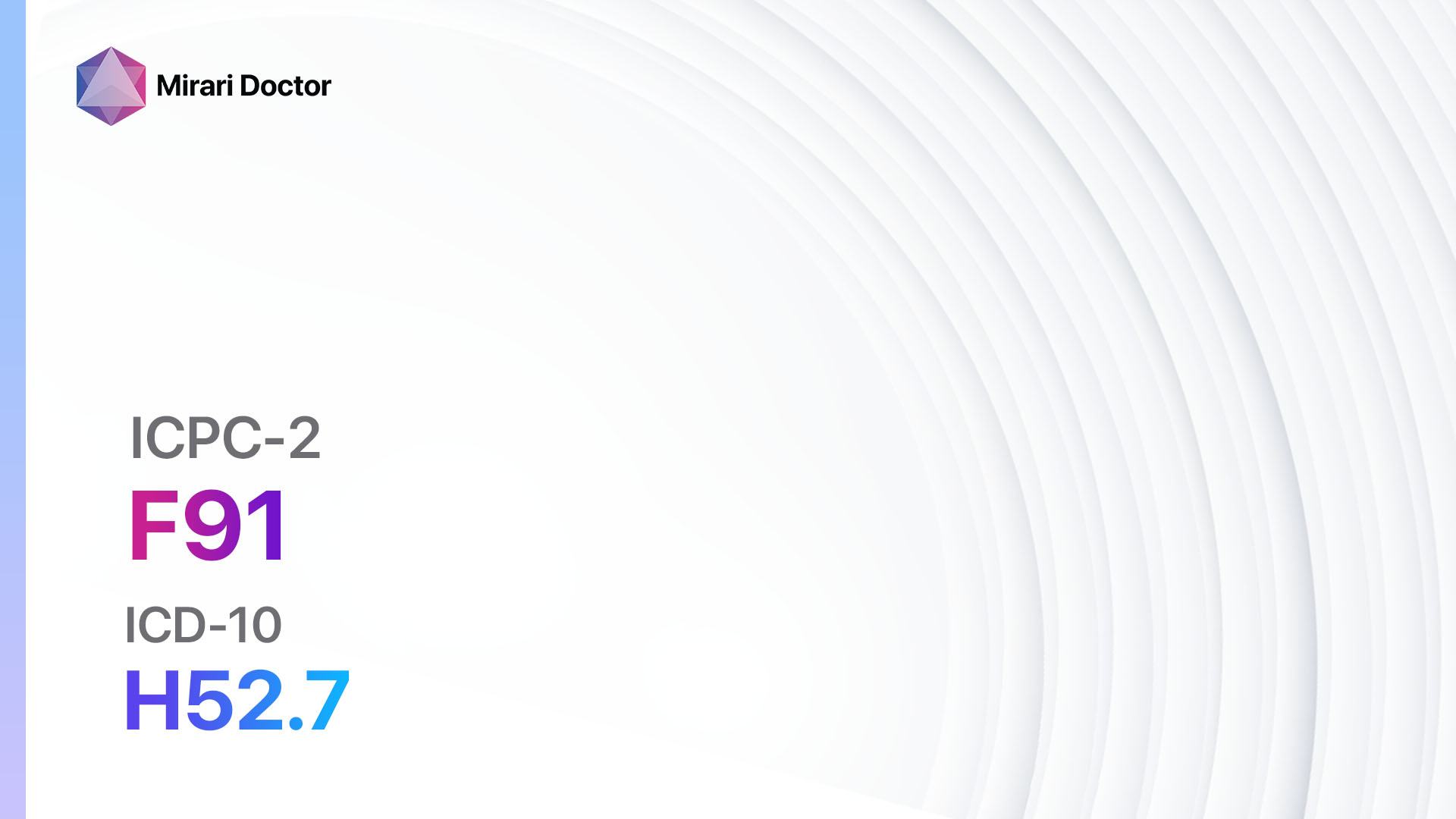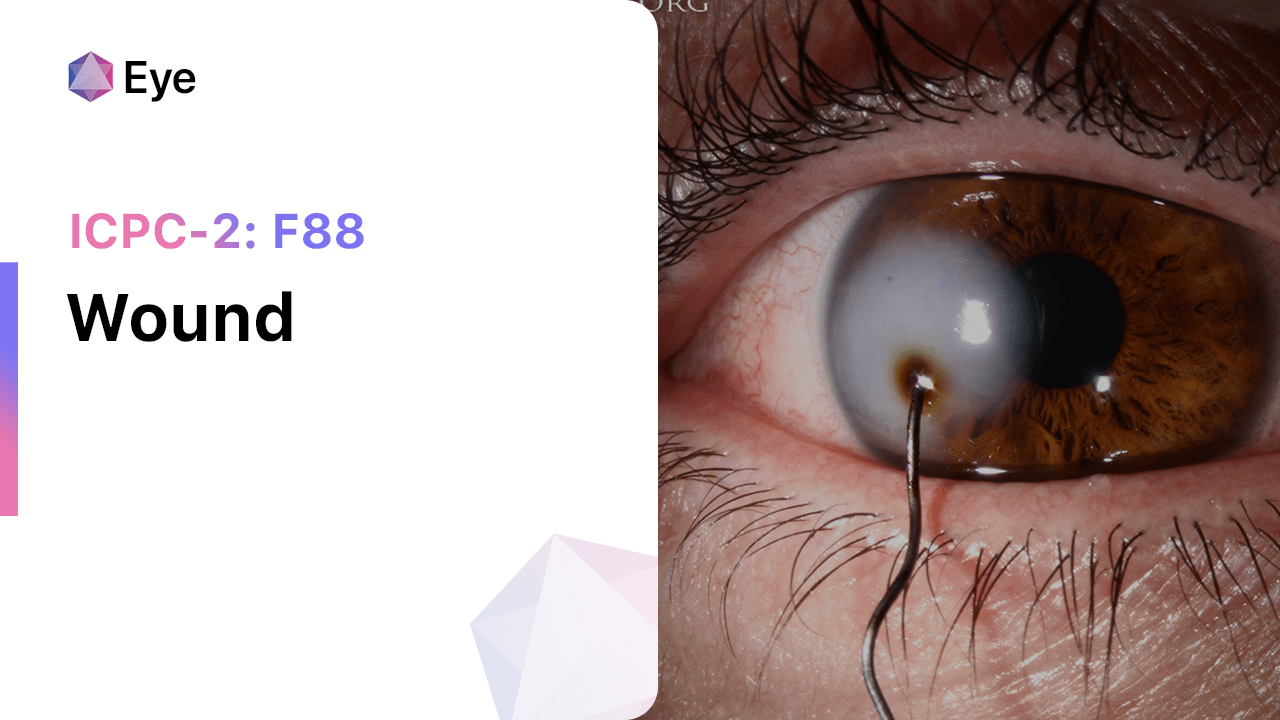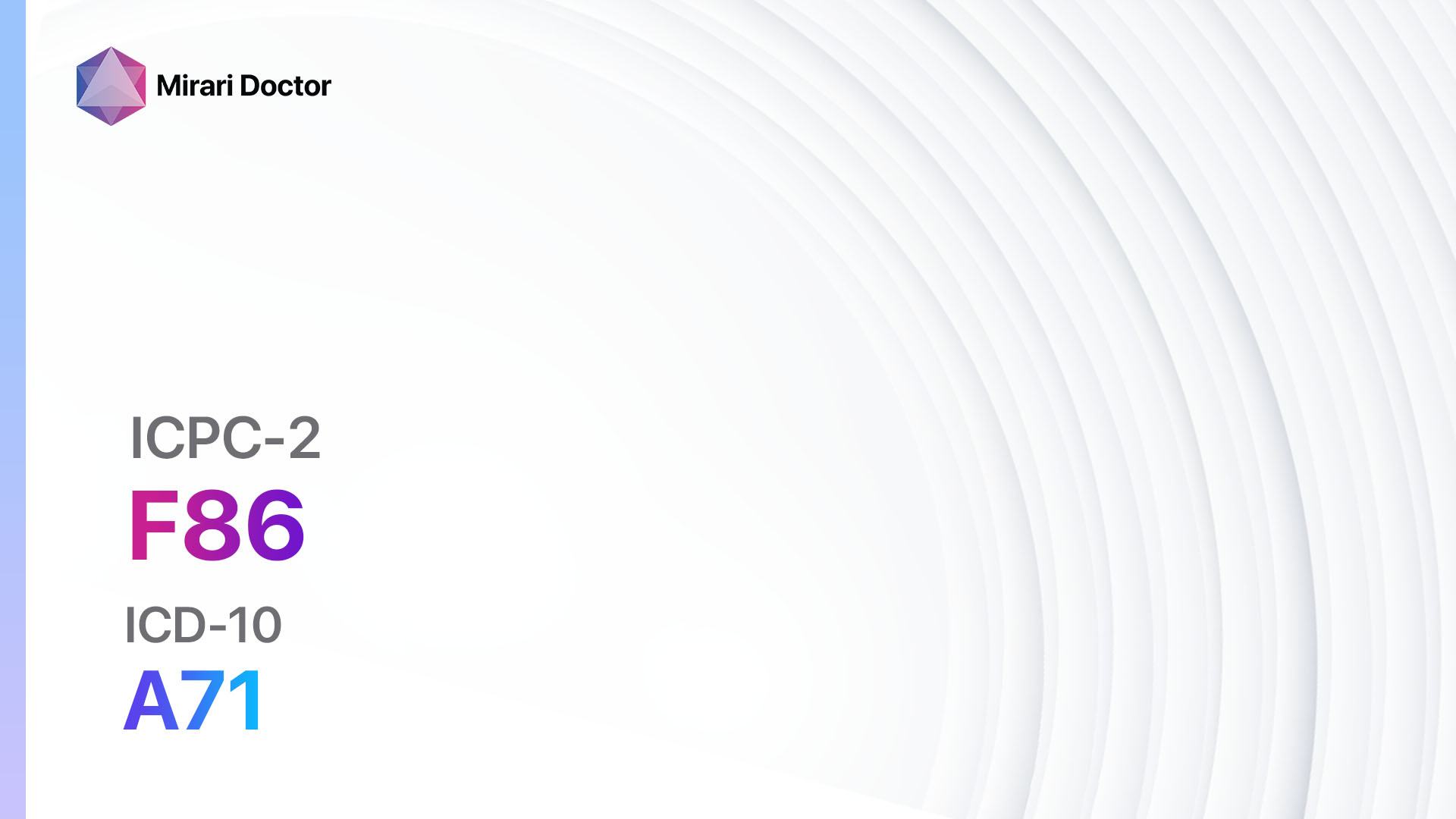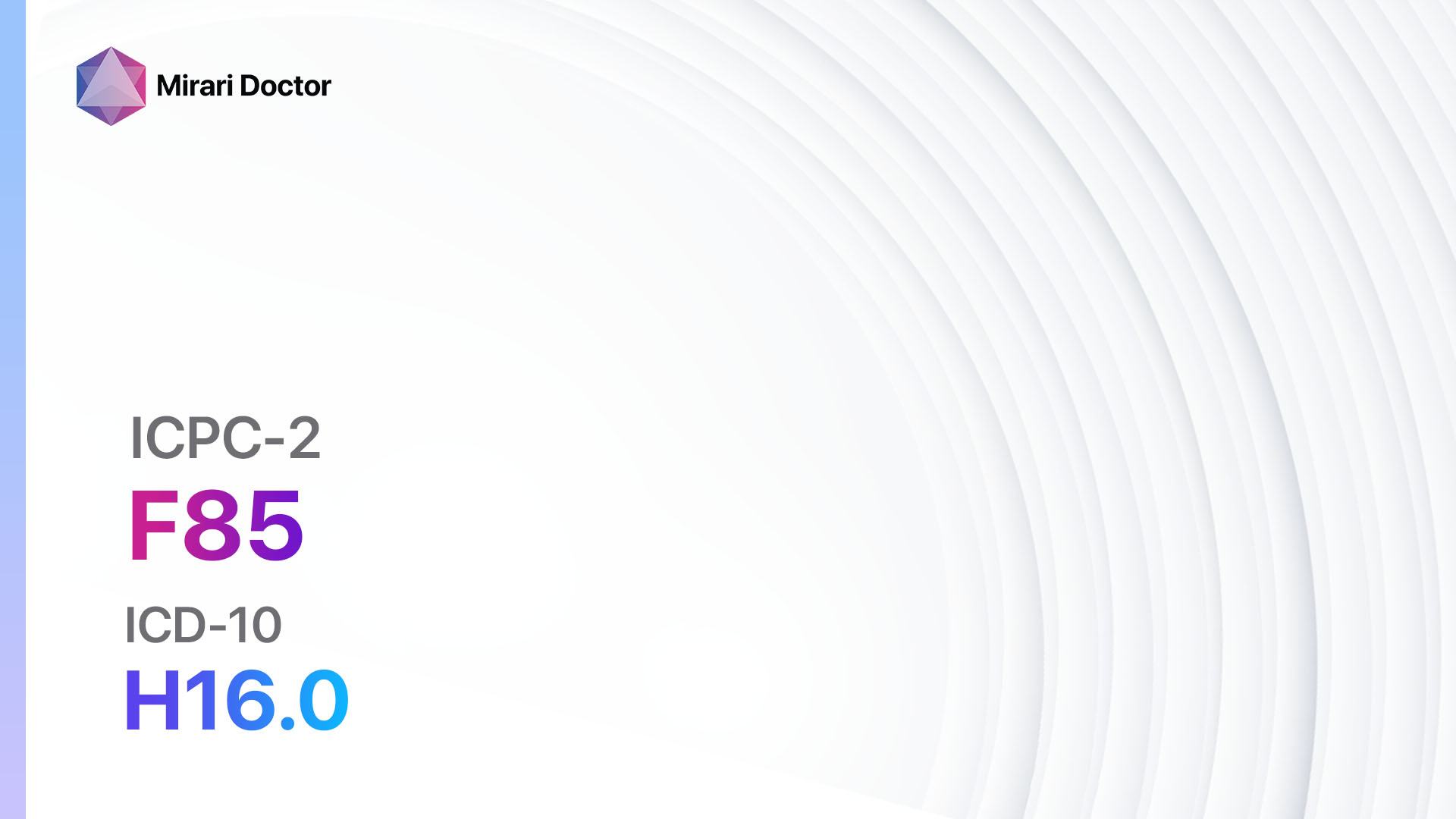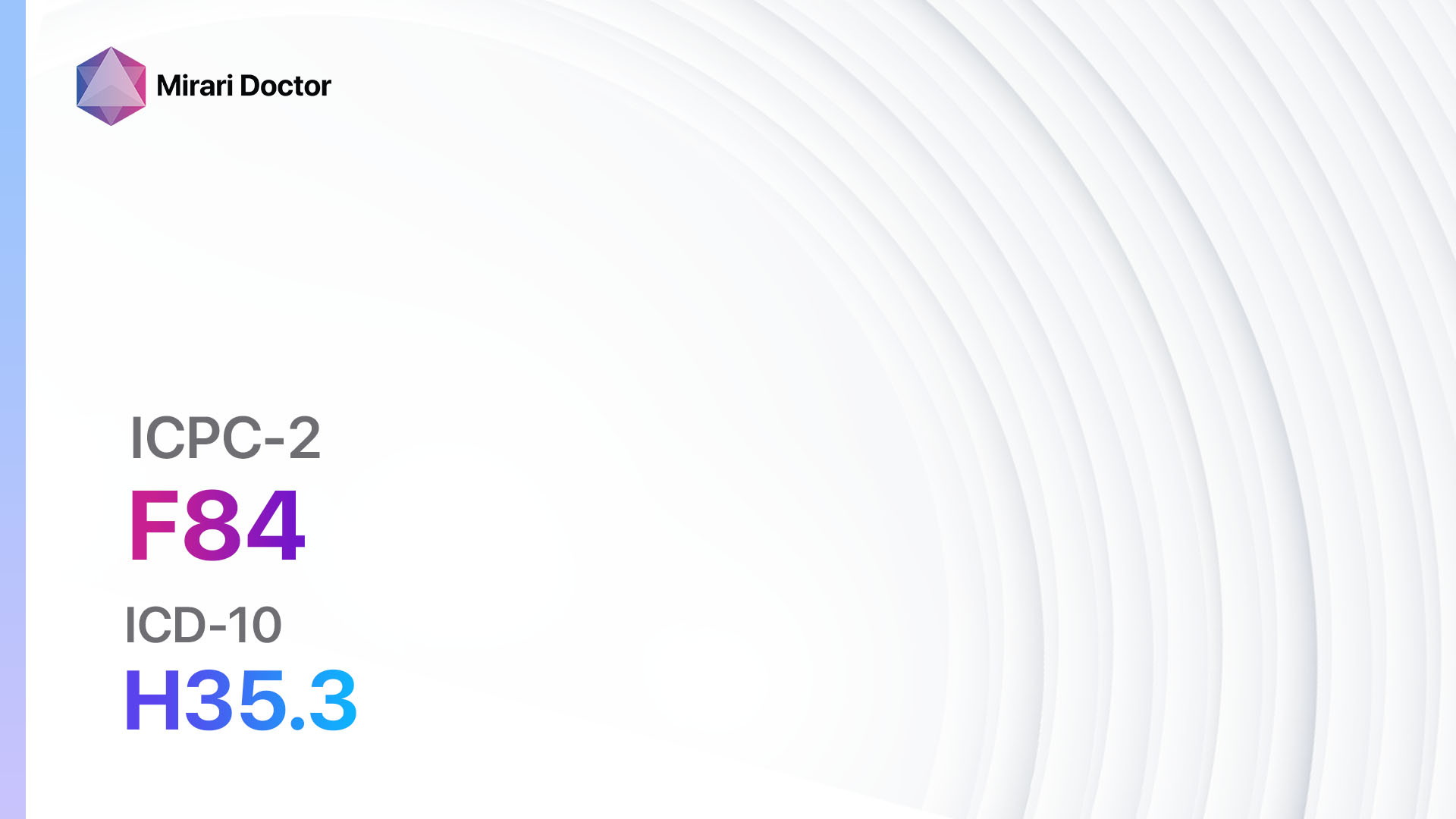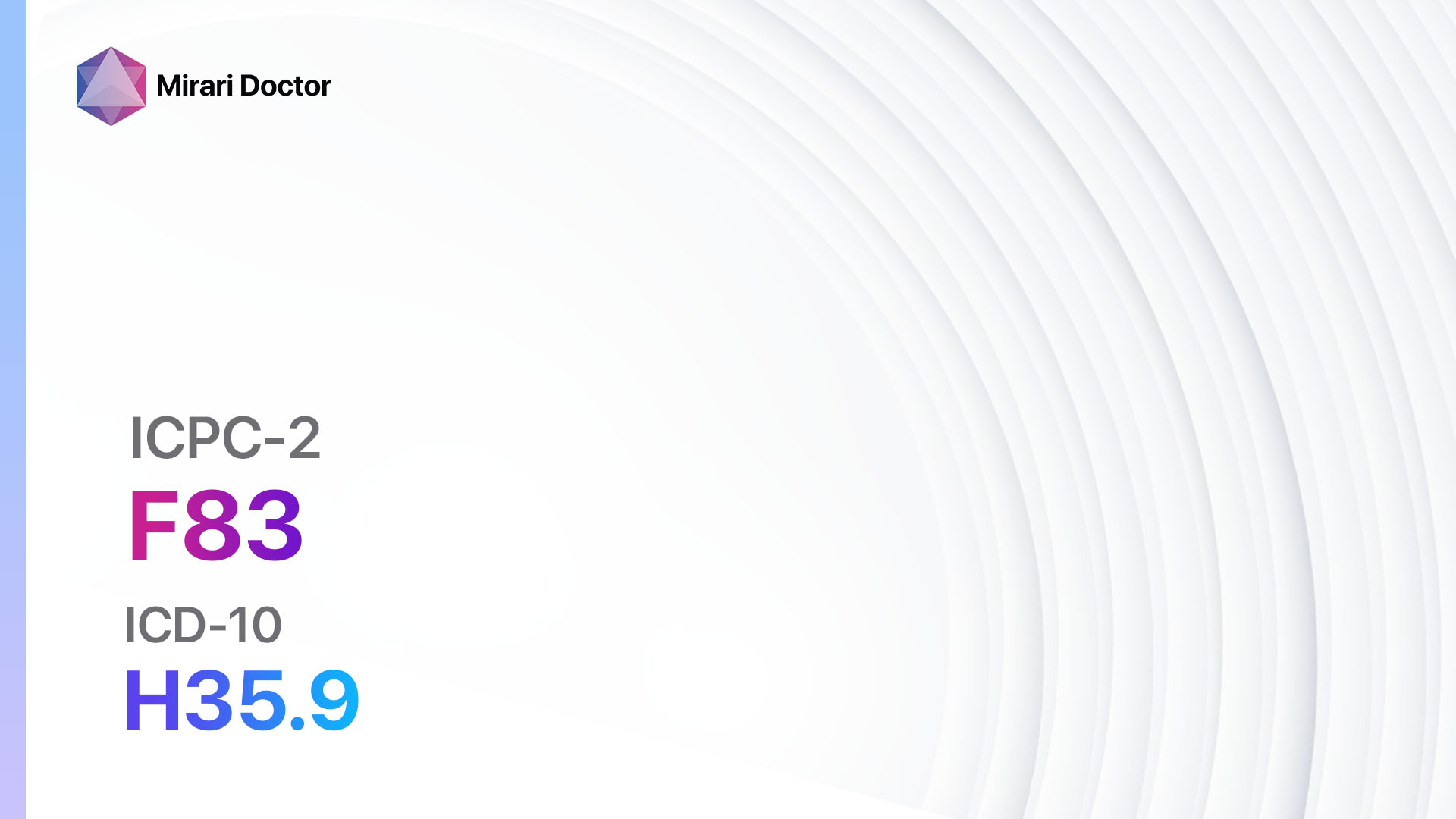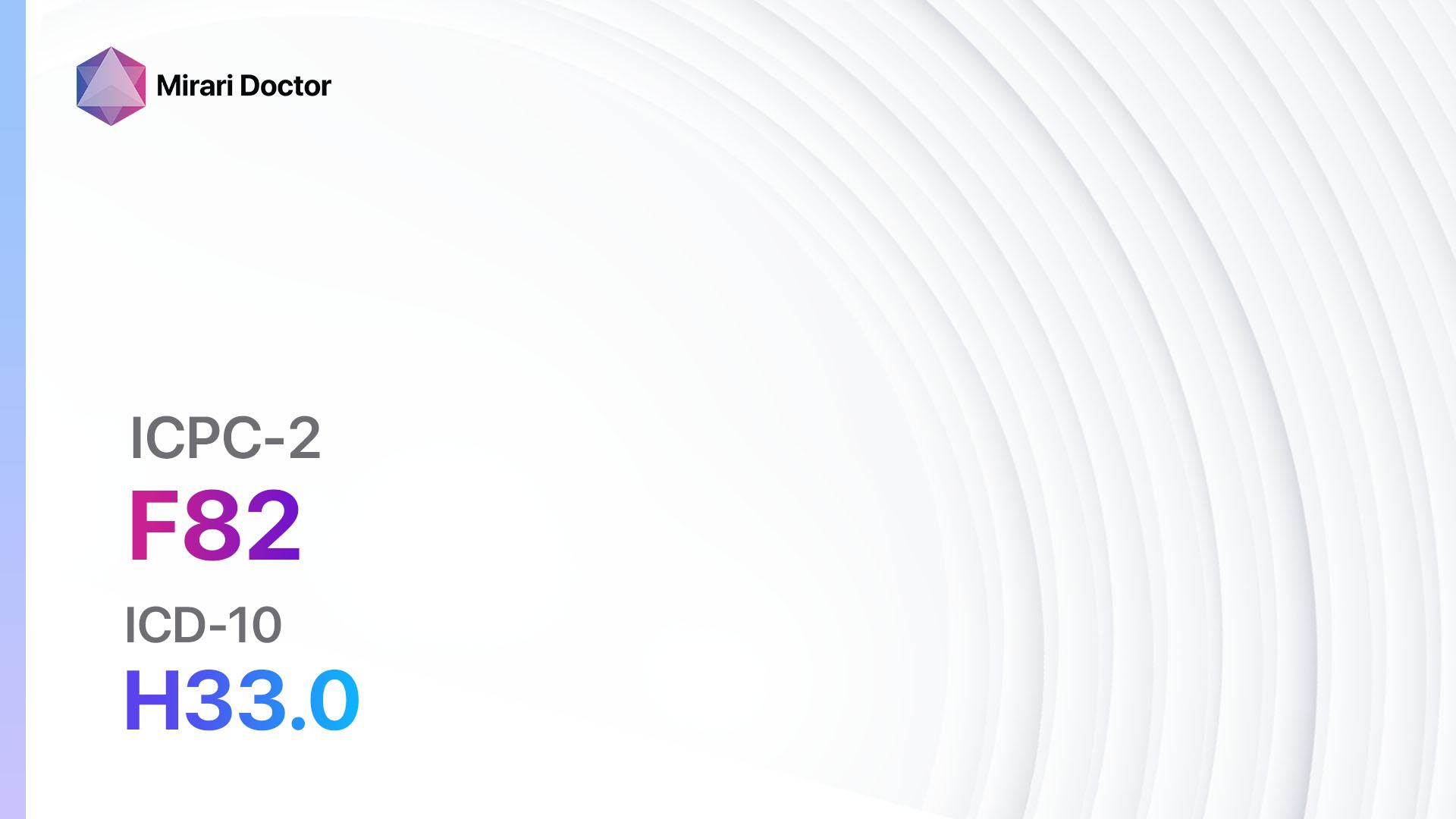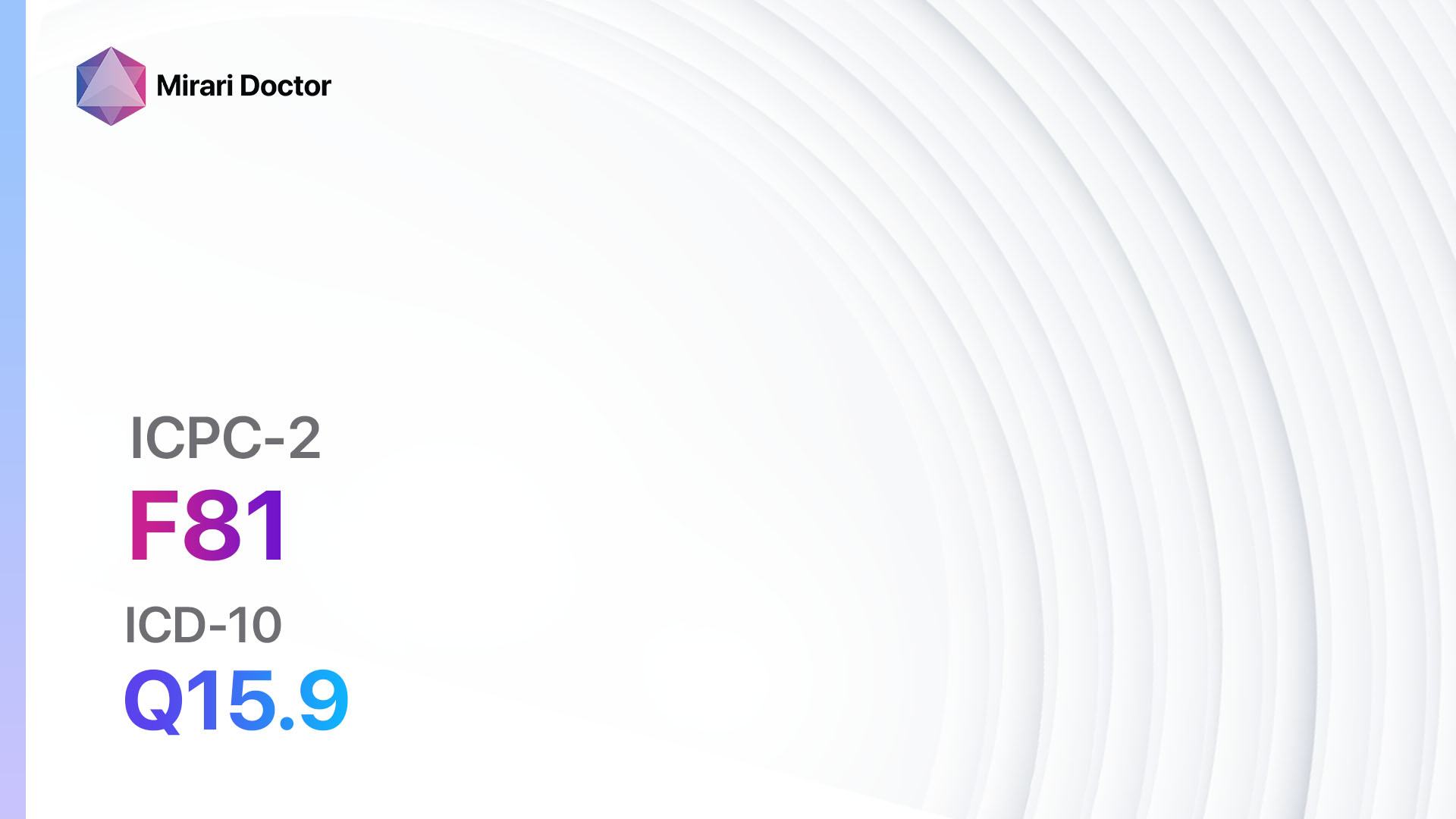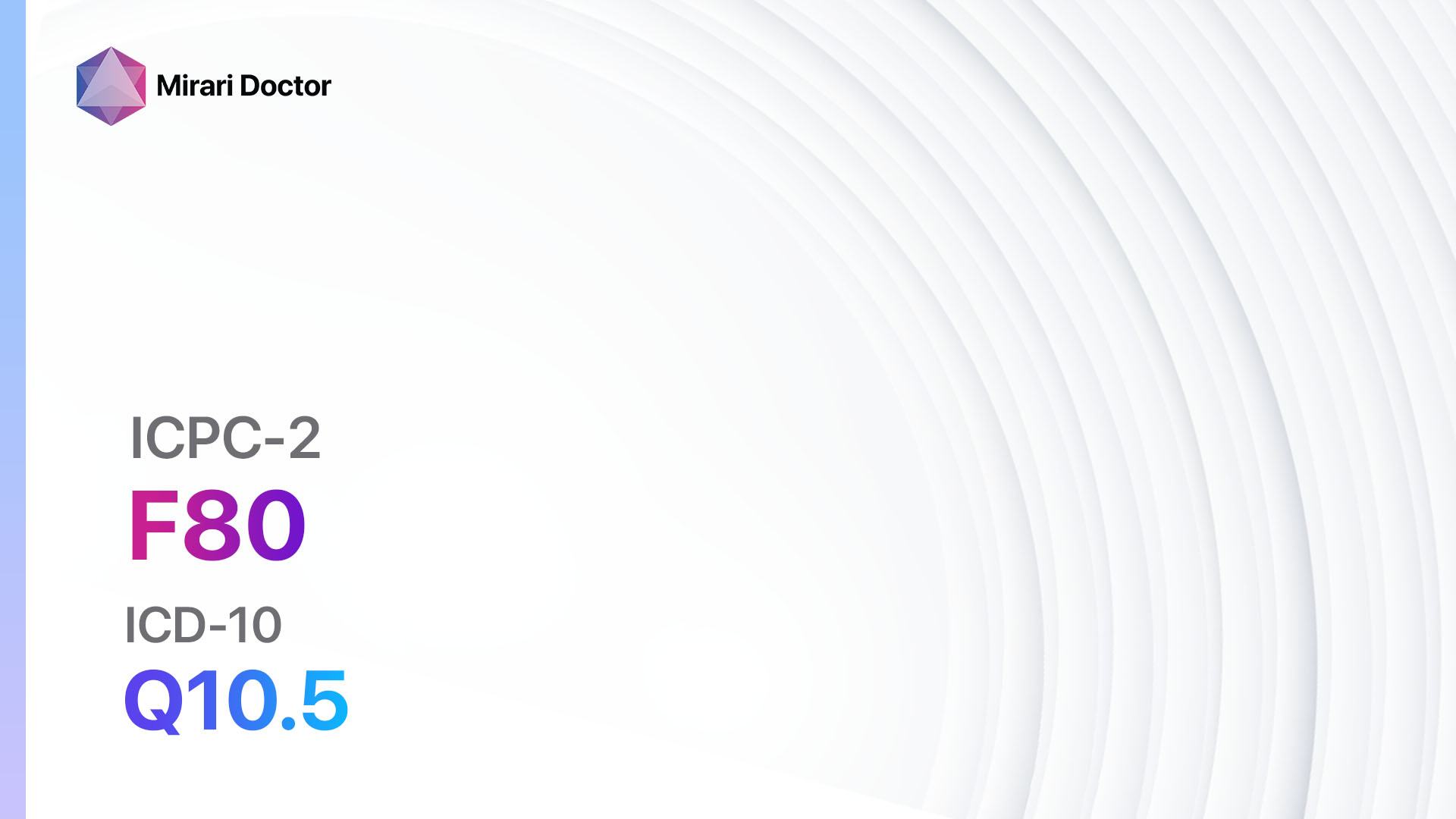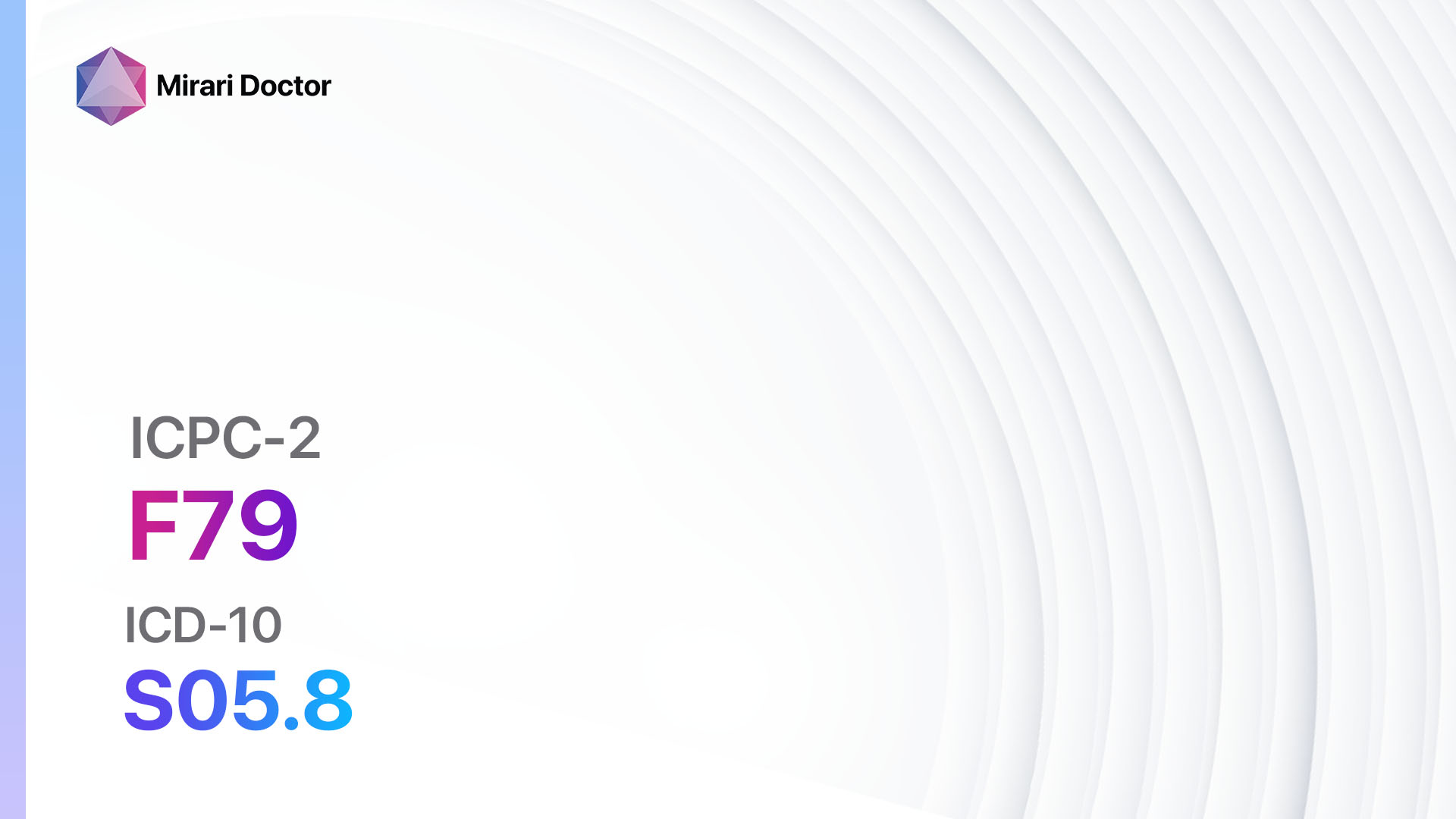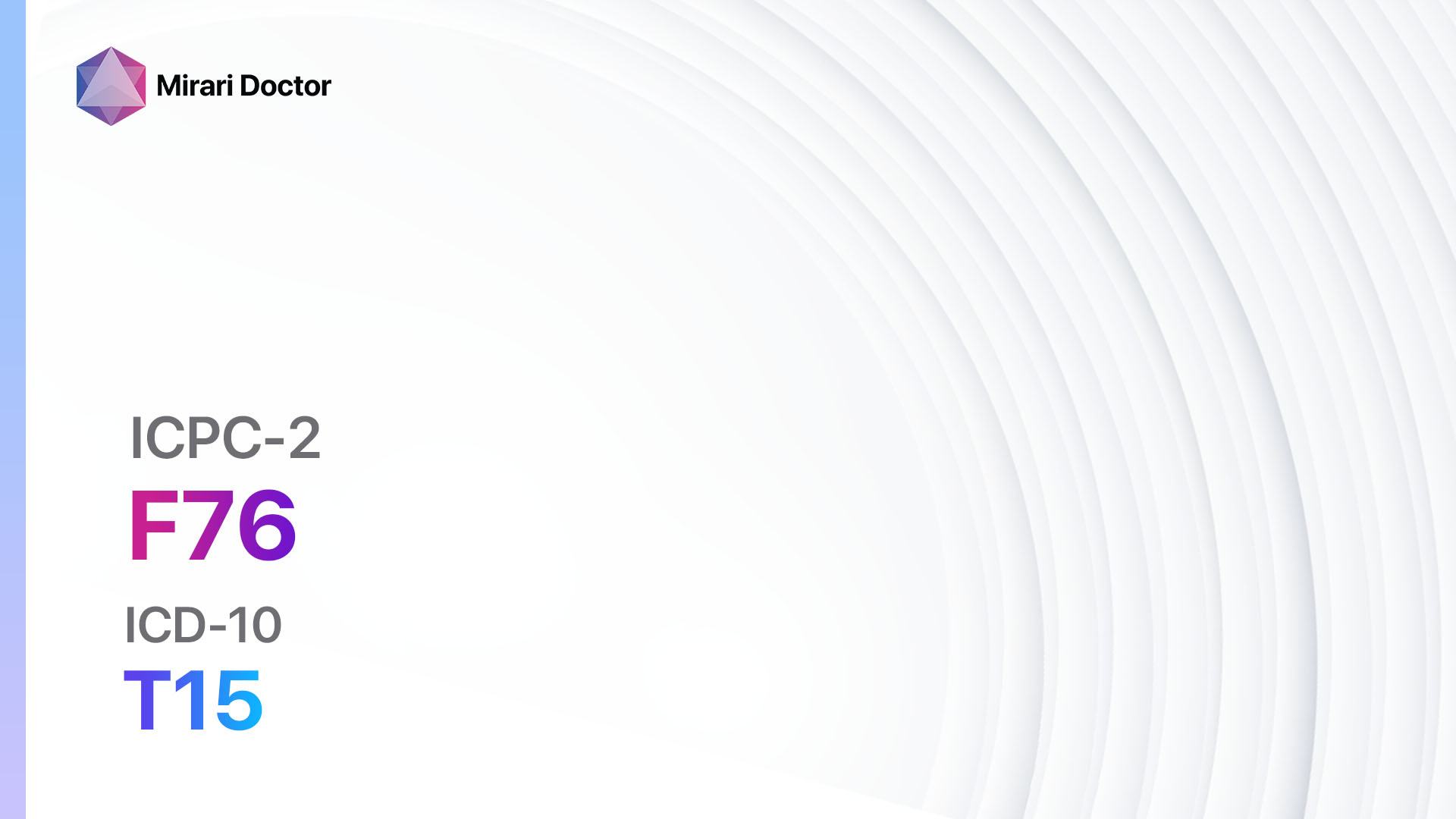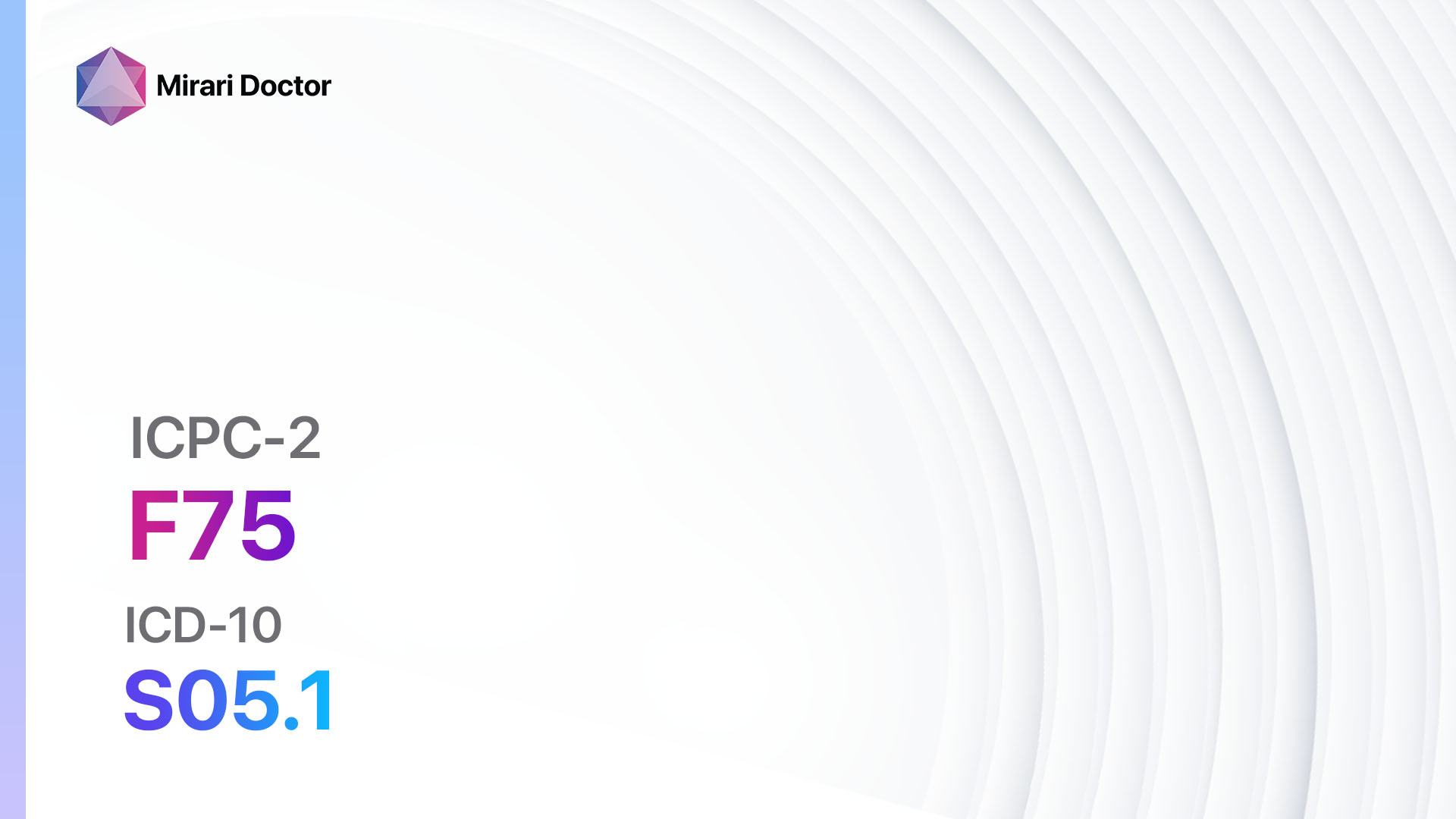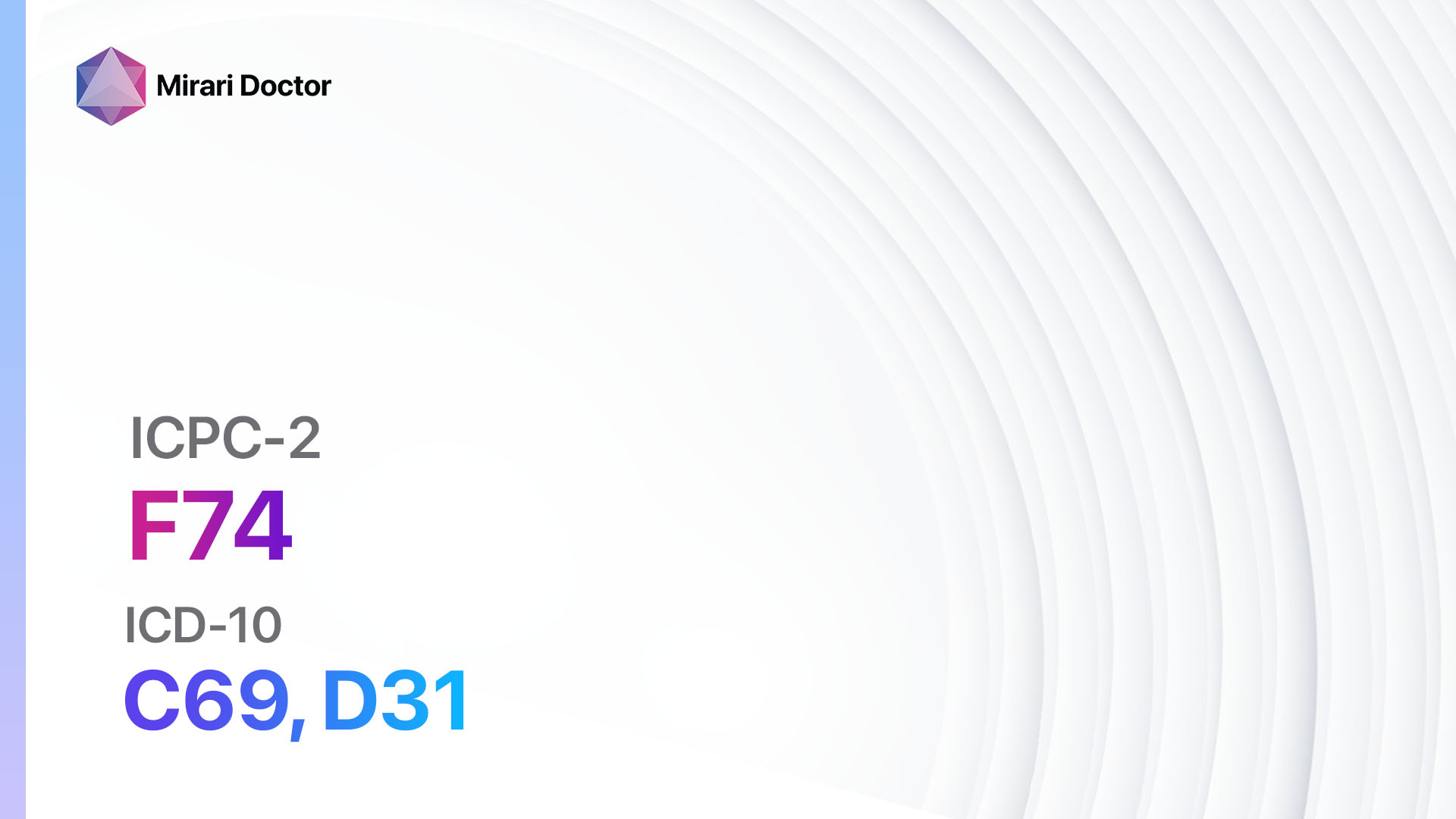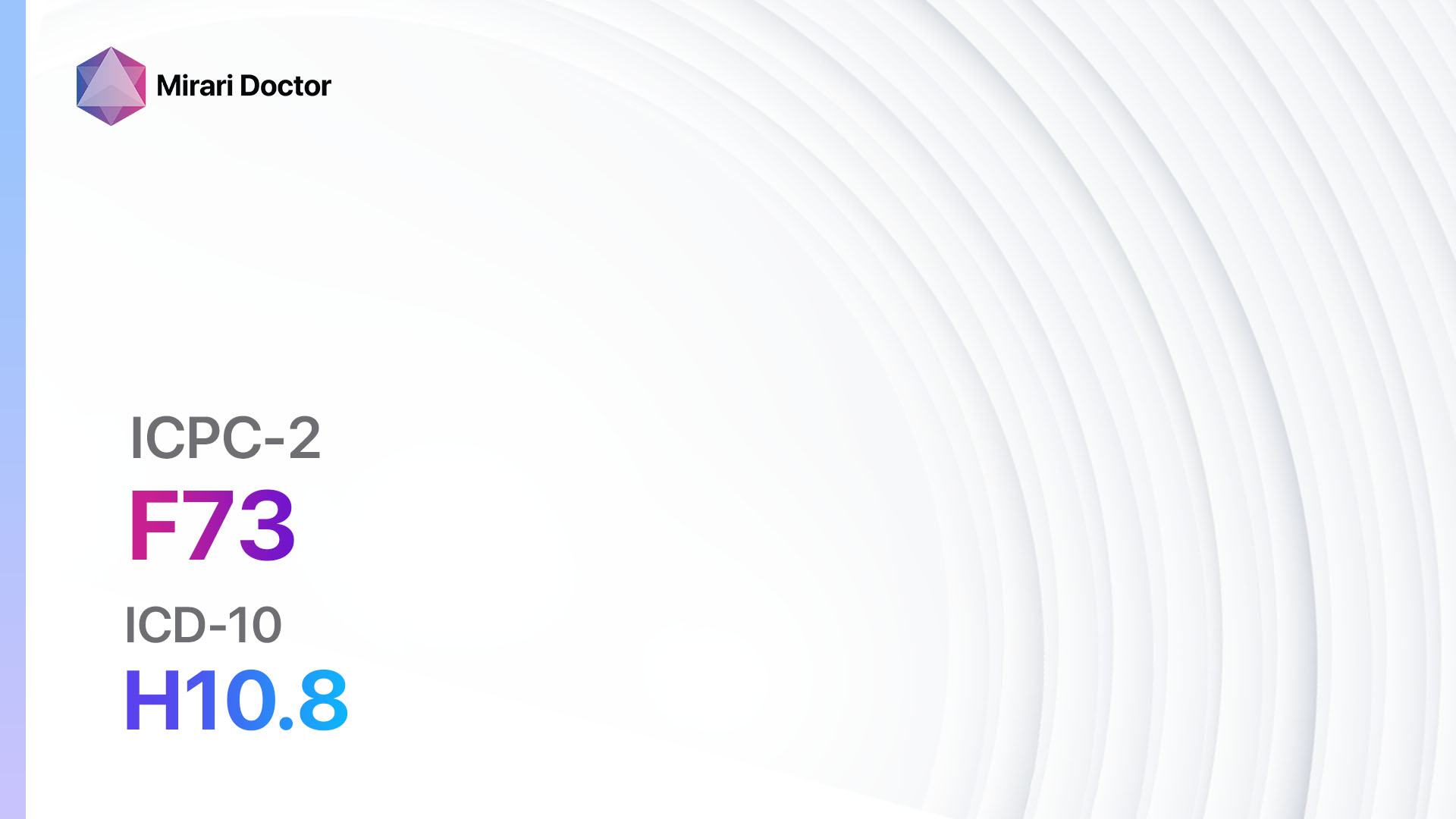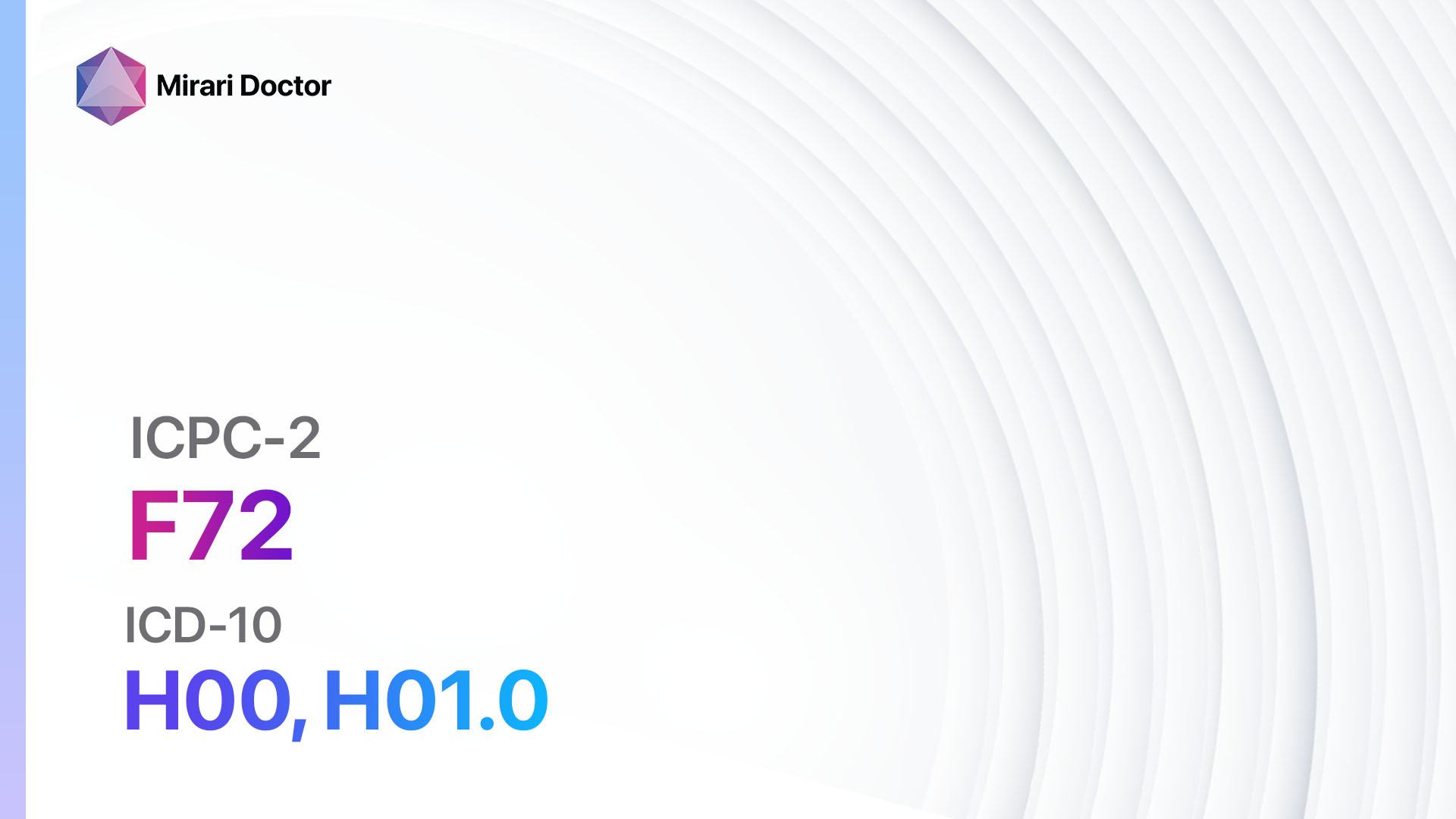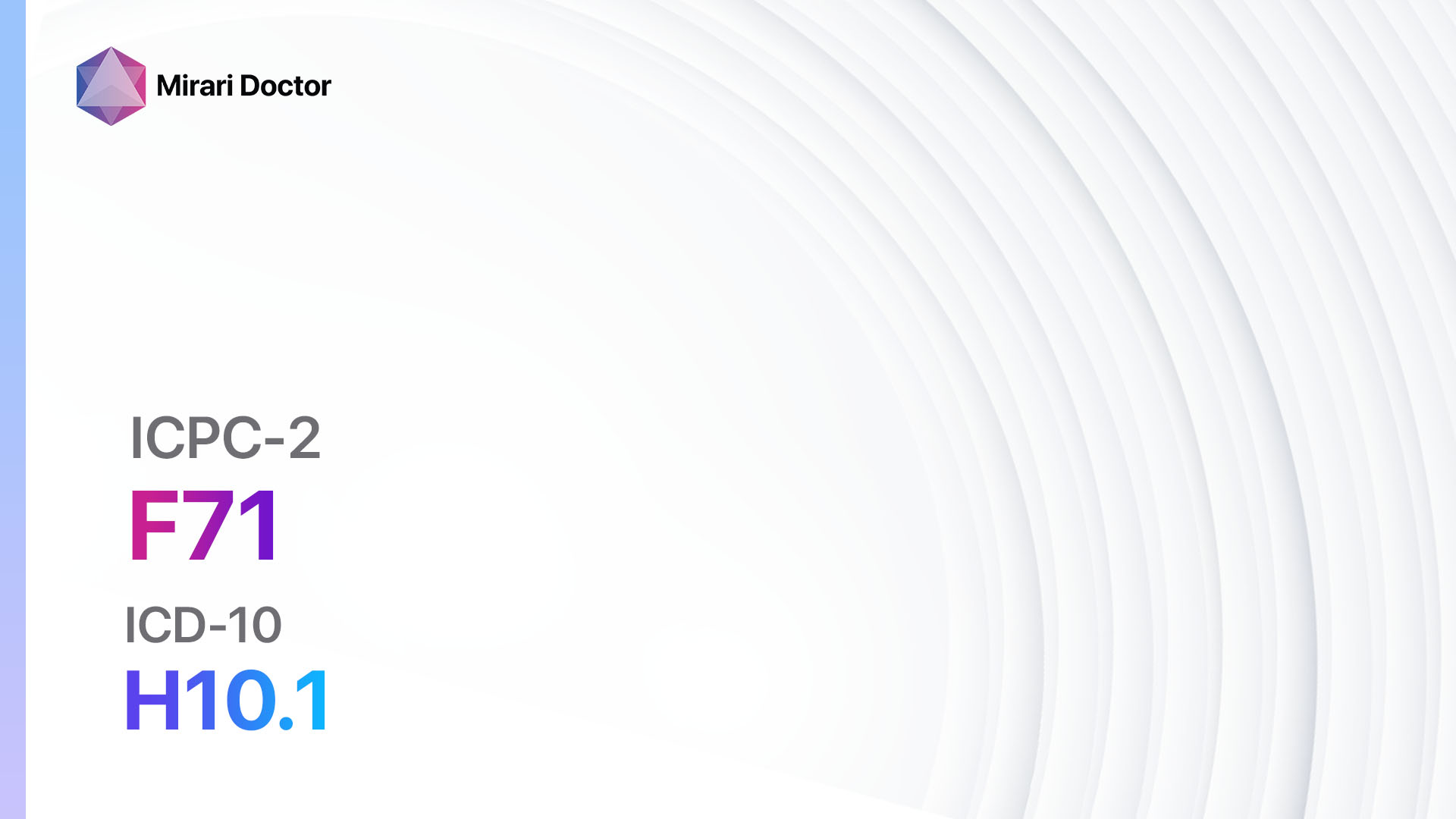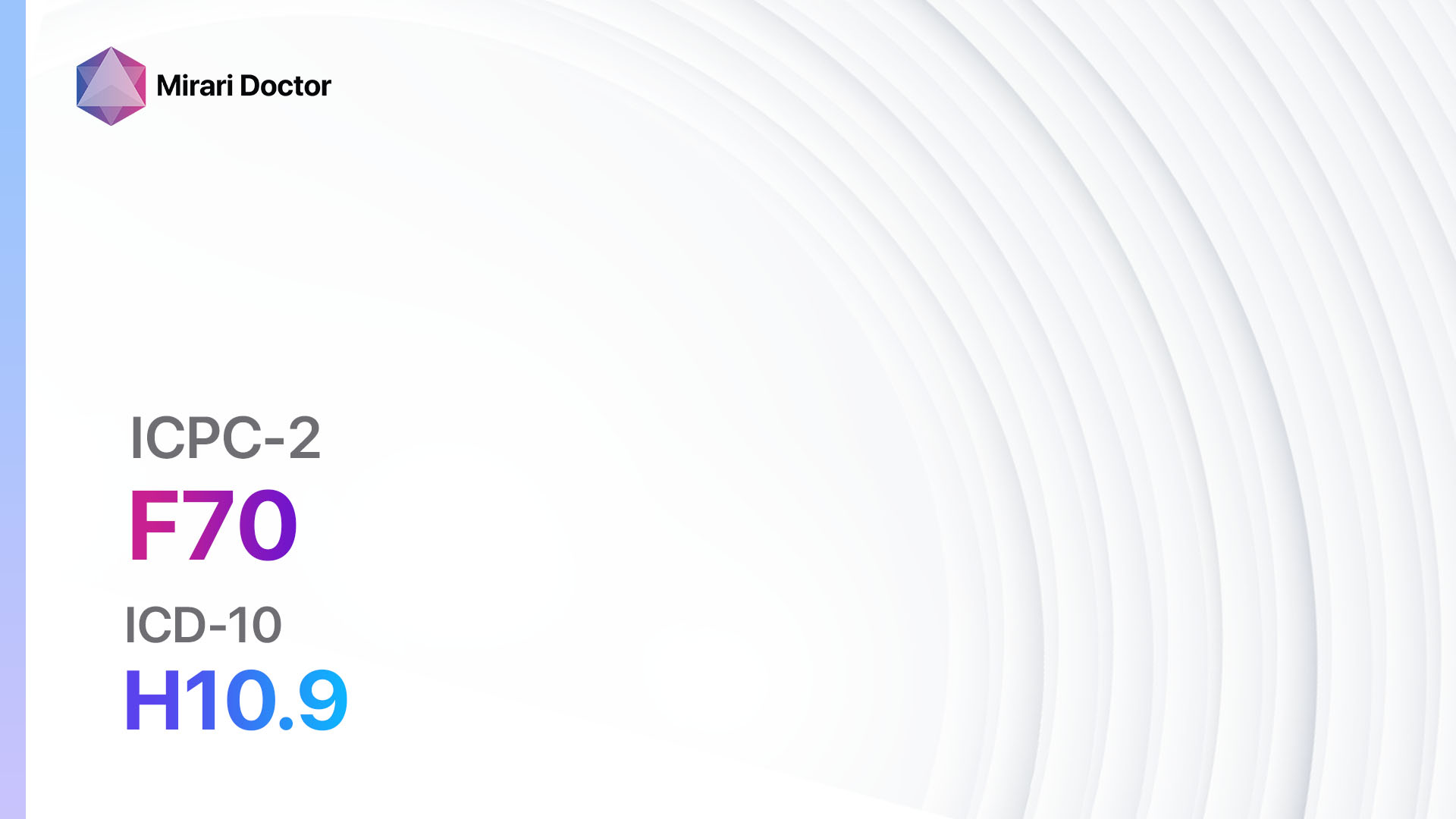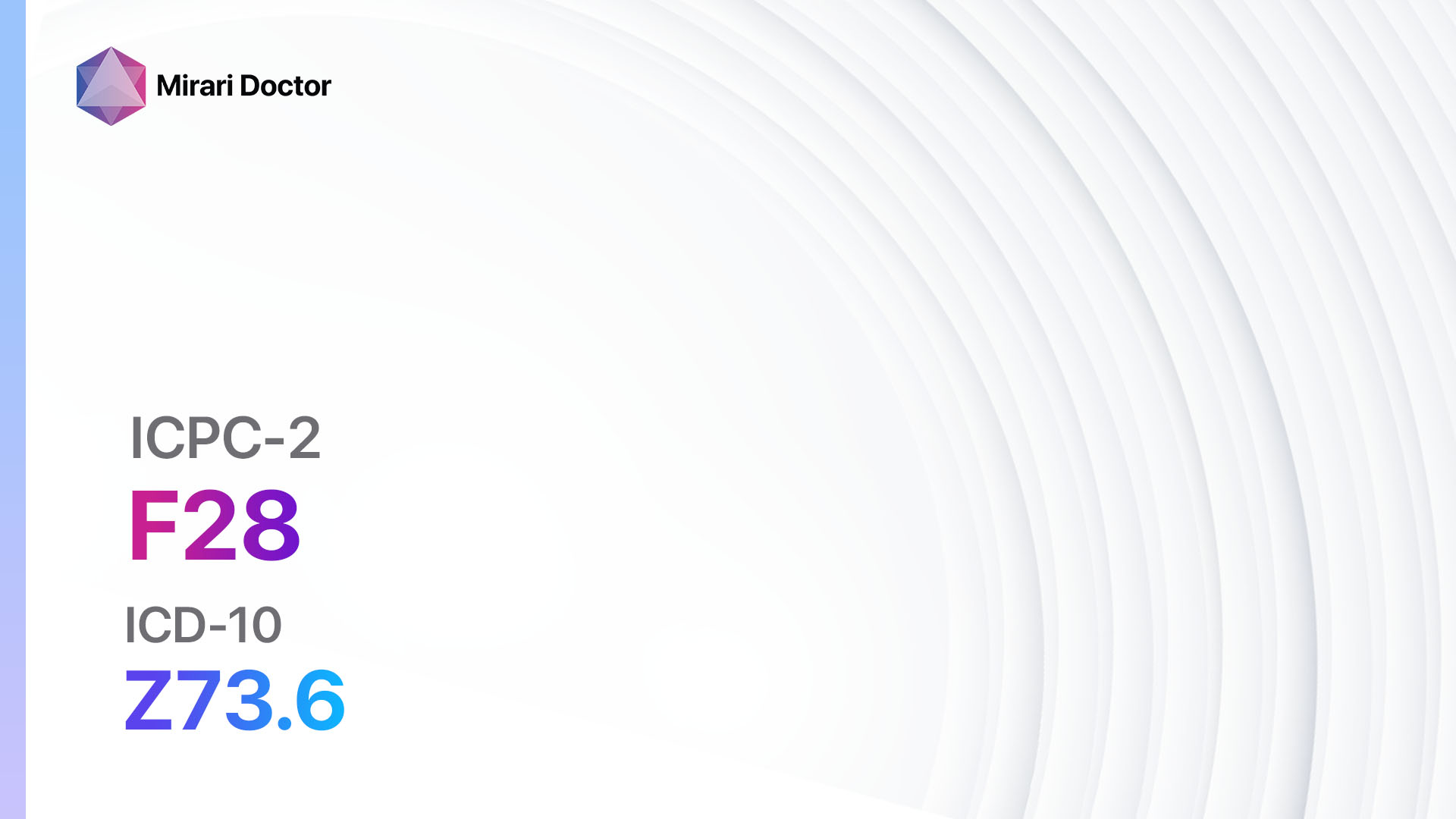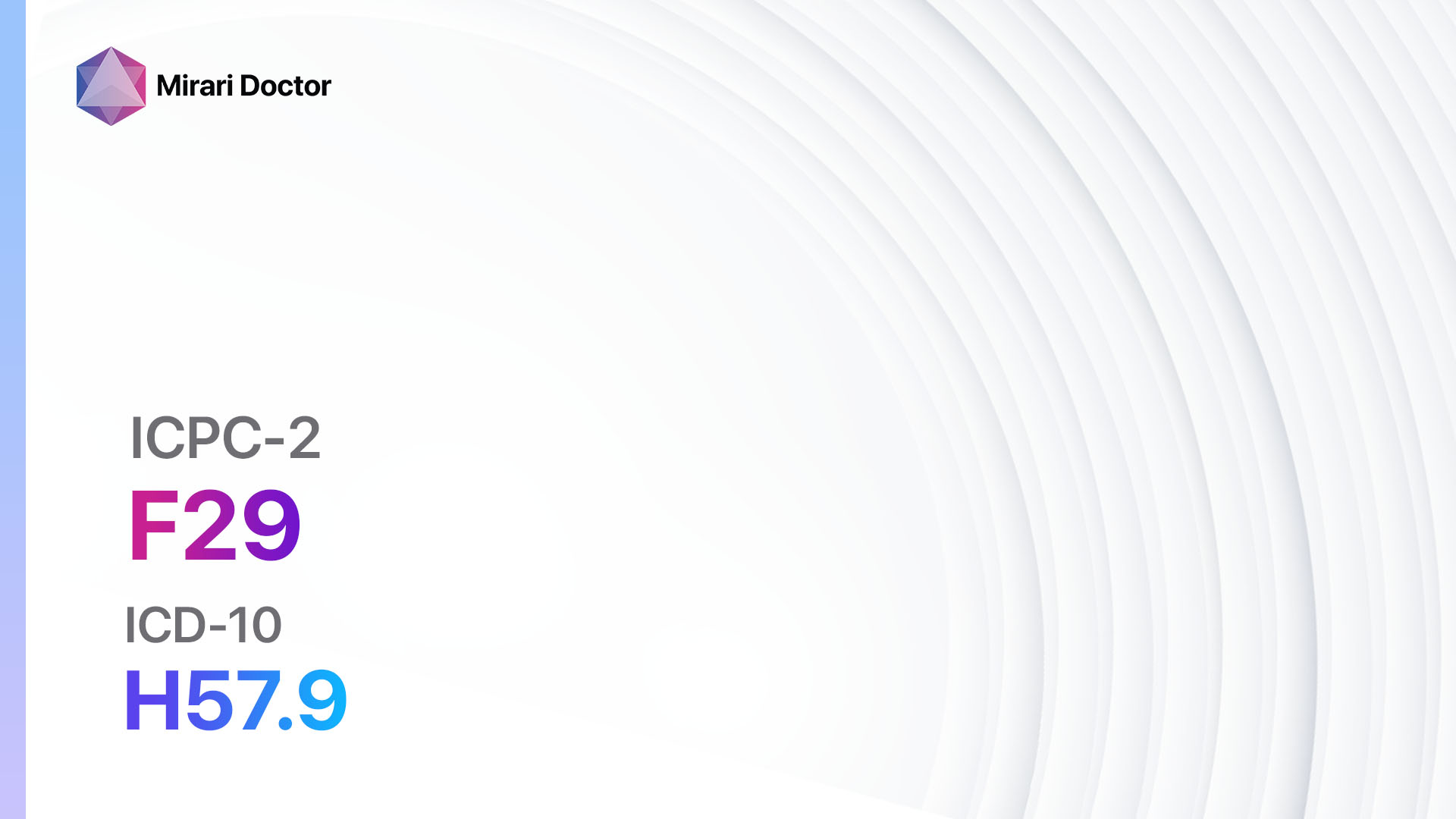
Introduction
Eye symptoms or complaints that do not fit into a specific category can be challenging to diagnose and treat. This guide aims to provide healthcare professionals with a comprehensive approach to evaluating and managing patients with eye symptoms or complaints that do not fall under a specific diagnosis. By following the steps outlined in this guide, healthcare professionals can gather relevant information, perform necessary examinations and tests, and provide appropriate interventions for their patients.[1][2]
Codes
- ICPC-2 Code: F29 Eye symptom/complaint other[3]
- ICD-10 Code: H57.9 Unspecified disorder of eye and adnexa[4]
Symptoms
- Blurred vision: Patients may complain of difficulty seeing clearly or a loss of sharpness in their vision.[5]
- Eye pain: Patients may experience discomfort or aching in one or both eyes.[6]
- Redness: The eyes may appear red or bloodshot.[7]
- Itching: Patients may report itching or a sensation of something in their eyes.[8]
- Dryness: Patients may complain of dry eyes or a gritty feeling.[9]
- Sensitivity to light: Patients may find bright lights or sunlight uncomfortable or painful.[10]
- Excessive tearing: Patients may have watery eyes without an obvious cause.
- Floaters: Patients may see small specks or spots floating in their field of vision.
- Flashes of light: Patients may see brief flashes or streaks of light.
- Double vision: Patients may see two images instead of one.
- Eye discharge: Patients may have a discharge from their eyes, which can be watery, sticky, or pus-like.
Causes
- Eye strain: Prolonged use of digital devices, reading, or other activities that require intense focus can lead to eye strain.
- Dry eye syndrome: Insufficient tear production or poor tear quality can result in dry eyes.
- Allergies: Allergic reactions to pollen, dust, or other irritants can cause eye symptoms.
- Conjunctivitis: Inflammation of the conjunctiva, often due to infection or allergies, can lead to redness, itching, and discharge.
- Foreign body: The presence of a foreign object in the eye can cause irritation and discomfort.
- Blepharitis: Inflammation of the eyelids can result in redness, itching, and crusting.
- Migraine: Some migraines can cause visual disturbances, such as flashes of light or temporary loss of vision.
- Refractive errors: Uncorrected nearsightedness, farsightedness, or astigmatism can cause blurred vision.
- Cataracts: Clouding of the lens in the eye can lead to blurred or dim vision.
- Glaucoma: Increased pressure in the eye can damage the optic nerve and cause vision loss.
- Retinal detachment: The detachment of the retina from the back of the eye can cause floaters, flashes of light, and a curtain-like shadow in the vision.
Diagnostic Steps
Medical History
- Gather information about the patient’s symptoms, including the duration, severity, and any associated factors (e.g., activities, time of day).
- Ask about any previous eye conditions or surgeries.
- Inquire about any medical conditions or medications that may contribute to eye symptoms.
- Assess for any risk factors, such as a family history of eye diseases or exposure to irritants.
Physical Examination
- Inspect the external structures of the eye, including the eyelids, conjunctiva, and sclera, for any abnormalities.
- Assess visual acuity using a Snellen chart or other appropriate methods.
- Perform a slit-lamp examination to evaluate the anterior segment of the eye, including the cornea, iris, and lens.
- Dilate the pupils to examine the posterior segment of the eye, including the retina and optic nerve.
- Measure intraocular pressure using tonometry to screen for glaucoma.
Laboratory Tests
- Complete blood count (CBC): To assess for any underlying systemic conditions that may contribute to eye symptoms.
- Allergy testing: If allergies are suspected as a cause of eye symptoms, specific allergens can be tested to identify triggers.
- Tear film evaluation: Tests such as tear breakup time (TBUT) and Schirmer’s test can assess tear production and quality in cases of dry eye syndrome.
Diagnostic Imaging
- Optical coherence tomography (OCT): This non-invasive imaging technique provides detailed cross-sectional images of the retina and can help diagnose conditions such as macular degeneration or diabetic retinopathy.
- Fundus photography: High-resolution images of the retina can be obtained to document any abnormalities or changes over time.
- Fluorescein angiography: This imaging technique uses a fluorescent dye to assess blood flow in the retina and can help diagnose conditions such as retinal vascular occlusions or macular degeneration.
Other Tests
- Visual field testing: This test assesses the patient’s peripheral vision and can help detect conditions such as glaucoma or optic nerve damage.
- Corneal topography: This test maps the curvature of the cornea and can aid in the diagnosis of conditions such as keratoconus or corneal dystrophies.
- Electroretinography (ERG): This test measures the electrical responses of the retina to light stimulation and can help diagnose retinal disorders.
Follow-up and Patient Education
- Schedule follow-up appointments as needed based on the patient’s condition and treatment plan.
- Provide education on proper eye care, including hygiene, use of lubricating eye drops, and protection from irritants or allergens.
- Discuss lifestyle modifications, such as reducing screen time or wearing protective eyewear, if applicable.
- Address any concerns or questions the patient may have regarding their eye symptoms or treatment.
Possible Interventions
Traditional Interventions
Medications:
Top 5 drugs for Eye symptom/complaint other:
- Artificial tears:
- Cost: $5-$15 per bottle.
- Contraindications: Hypersensitivity to ingredients.
- Side effects: Temporary blurring of vision.
- Severe side effects: None reported.
- Drug interactions: None reported.
- Warning: Use as directed and avoid contamination of the bottle.
- Antihistamine eye drops (e.g., Ketotifen):
- Cost: $10-$20 per bottle.
- Contraindications: Hypersensitivity to ingredients.
- Side effects: Temporary stinging or burning sensation.
- Severe side effects: None reported.
- Drug interactions: None reported.
- Warning: Use as directed and avoid contact with soft contact lenses.
- Topical corticosteroids (e.g., Prednisolone):
- Cost: $10-$30 per tube.
- Contraindications: Active viral, fungal, or bacterial eye infections.
- Side effects: Increased intraocular pressure, cataract formation.
- Severe side effects: None reported with short-term use.
- Drug interactions: None reported.
- Warning: Use under the supervision of an ophthalmologist.
- Antibiotic eye drops (e.g., Tobramycin):
- Cost: $10-$30 per bottle.
- Contraindications: Hypersensitivity to ingredients.
- Side effects: Temporary stinging or burning sensation.
- Severe side effects: None reported.
- Drug interactions: None reported.
- Warning: Use as directed and complete the full course of treatment.
- Nonsteroidal anti-inflammatory drugs (NSAIDs) eye drops (e.g., Ketorolac):
- Cost: $15-$30 per bottle.
- Contraindications: Active peptic ulcer disease, bleeding disorders.
- Side effects: Temporary stinging or burning sensation.
- Severe side effects: None reported.
- Drug interactions: None reported.
- Warning: Use as directed and avoid contact with soft contact lenses.
Alternative Drugs:
- Lubricating ointments: Provides longer-lasting relief for severe dry eye symptoms. Cost: $10-$20 per tube.
- Mast cell stabilizers: Helps prevent allergic reactions and reduce itching. Cost: $10-$20 per bottle.
- Cyclosporine eye drops: Used for chronic dry eye syndrome. Cost: $100-$200 per bottle.
- Antiviral eye drops: Used for viral eye infections such as herpes simplex keratitis. Cost: $50-$100 per bottle.
- Carbonic anhydrase inhibitors: Reduces intraocular pressure in glaucoma. Cost: $50-$100 per bottle.
Surgical Procedures:
- Laser eye surgery: Corrects refractive errors such as nearsightedness, farsightedness, or astigmatism. Cost: $1,500-$3,000 per eye.
- Cataract surgery: Removes the cloudy lens and replaces it with an artificial lens. Cost: $3,000-$5,000 per eye.
- Glaucoma surgery: Various surgical procedures are available to lower intraocular pressure and prevent vision loss. Cost: $2,000-$5,000 per eye.
Alternative Interventions
- Acupuncture: May help alleviate eye strain and improve blood flow to the eyes. Cost: $60-$120 per session.
- Herbal supplements: Some herbs, such as bilberry or ginkgo biloba, are believed to support eye health. Cost: Varies depending on the specific supplement.
- Eye exercises: Certain exercises may help strengthen eye muscles and improve focus. Cost: Free.
- Warm compresses: Applying warm compresses to the eyes can help relieve dryness and discomfort. Cost: Free.
- Aromatherapy: Using essential oils, such as lavender or chamomile, may promote relaxation and reduce eye strain. Cost: Varies depending on the specific oil.
Lifestyle Interventions
- Proper eye hygiene: Encourage patients to wash their hands before touching their eyes and to avoid rubbing their eyes excessively.
- Reduce screen time: Advise patients to take regular breaks from digital devices and to use the 20-20-20 rule (every 20 minutes, look at something 20 feet away for 20 seconds).
- Protective eyewear: Recommend wearing sunglasses with UV protection and safety goggles when engaging in activities that may pose a risk to the eyes.
- Maintain a healthy diet: Encourage patients to consume a diet rich in fruits, vegetables, and omega-3 fatty acids to support eye health.
- Quit smoking: Advise patients to quit smoking, as smoking is associated with an increased risk of eye diseases.
It is important to note that the cost ranges provided are approximate and may vary depending on the location and availability of the interventions.
Mirari Cold Plasma Alternative Intervention
Understanding Mirari Cold Plasma
- Safe and Non-Invasive Treatment: Mirari Cold Plasma is a safe and non-invasive treatment option for various skin conditions. It does not require incisions, minimizing the risk of scarring, bleeding, or tissue damage.
- Efficient Extraction of Foreign Bodies: Mirari Cold Plasma facilitates the removal of foreign bodies from the skin by degrading and dissociating organic matter, allowing easier access and extraction.
- Pain Reduction and Comfort: Mirari Cold Plasma has a local analgesic effect, providing pain relief during the treatment, making it more comfortable for the patient.
- Reduced Risk of Infection: Mirari Cold Plasma has antimicrobial properties, effectively killing bacteria and reducing the risk of infection.
- Accelerated Healing and Minimal Scarring: Mirari Cold Plasma stimulates wound healing and tissue regeneration, reducing healing time and minimizing the formation of scars.
Mirari Cold Plasma Prescription
Video instructions for using Mirari Cold Plasma Device – F29 Eye symptom/complaint other (ICD-10:H57.9)
| Mild | Moderate | Severe |
| Mode setting: 1 (Infection) Location: 7 (Neuro system & ENT) Morning: 15 minutes, Evening: 15 minutes |
Mode setting: 1 (Infection) Location: 7 (Neuro system & ENT) Morning: 30 minutes, Lunch: 30 minutes, Evening: 30 minutes |
Mode setting: 1 (Infection) Location: 7 (Neuro system & ENT) Morning: 30 minutes, Lunch: 30 minutes, Evening: 30 minutes |
| Mode setting: 2 (Wound Healing) Location: 7 (Neuro system & ENT) Morning: 15 minutes, Evening: 15 minutes |
Mode setting: 2 (Wound Healing) Location: 7 (Neuro system & ENT) Morning: 30 minutes, Lunch: 30 minutes, Evening: 30 minutes |
Mode setting: 2 (Wound Healing) Location: 7 (Neuro system & ENT) Morning: 30 minutes, Lunch: 30 minutes, Evening: 30 minutes |
| Mode setting: 3 (Antiviral Therapy) Location: 7 (Neuro system & ENT) Morning: 15 minutes, Evening: 15 minutes |
Mode setting: 3 (Antiviral Therapy) Location: 7 (Neuro system & ENT) Morning: 30 minutes, Lunch: 30 minutes, Evening: 30 minutes |
Mode setting: 3 (Antiviral Therapy) Location: 7 (Neuro system & ENT) Morning: 30 minutes, Lunch: 30 minutes, Evening: 30 minutes |
| Total Morning: 45 minutes approx. $7.50 USD, Evening: 45 minutes approx. $7.50 USD |
Total Morning: 90 minutes approx. $15 USD, Lunch: 90 minutes approx. $15 USD, Evening: 90 minutes approx. $15 USD, |
Total Morning: 90 minutes approx. $15 USD, Lunch: 90 minutes approx. $15 USD, Evening: 90 minutes approx. $15 USD, |
| Usual treatment for 7-60 days approx. $105 USD – $900 USD | Usual treatment for 6-8 weeks approx. $1,890 USD – $2,520 USD |
Usual treatment for 3-6 months approx. $4,050 USD – $8,100 USD
|
 |
|
Use the Mirari Cold Plasma device to treat Eye symptom/complaint other effectively.
WARNING: MIRARI COLD PLASMA IS DESIGNED FOR THE HUMAN BODY WITHOUT ANY ARTIFICIAL OR THIRD PARTY PRODUCTS. USE OF OTHER PRODUCTS IN COMBINATION WITH MIRARI COLD PLASMA MAY CAUSE UNPREDICTABLE EFFECTS, HARM OR INJURY. PLEASE CONSULT A MEDICAL PROFESSIONAL BEFORE COMBINING ANY OTHER PRODUCTS WITH USE OF MIRARI.
Step 1: Cleanse the Skin
- Start by cleaning the affected area of the skin with a gentle cleanser or mild soap and water. Gently pat the area dry with a clean towel.
Step 2: Prepare the Mirari Cold Plasma device
- Ensure that the Mirari Cold Plasma device is fully charged or has fresh batteries as per the manufacturer’s instructions. Make sure the device is clean and in good working condition.
- Switch on the Mirari device using the power button or by following the specific instructions provided with the device.
- Some Mirari devices may have adjustable settings for intensity or treatment duration. Follow the manufacturer’s instructions to select the appropriate settings based on your needs and the recommended guidelines.
Step 3: Apply the Device
- Place the Mirari device in direct contact with the affected area of the skin. Gently glide or hold the device over the skin surface, ensuring even coverage of the area experiencing.
- Slowly move the Mirari device in a circular motion or follow a specific pattern as indicated in the user manual. This helps ensure thorough treatment coverage.
Step 4: Monitor and Assess:
- Keep track of your progress and evaluate the effectiveness of the Mirari device in managing your Eye symptom/complaint other. If you have any concerns or notice any adverse reactions, consult with your health care professional.
Note
This guide is for informational purposes only and should not replace the advice of a medical professional. Always consult with your healthcare provider or a qualified medical professional for personal advice, diagnosis, or treatment. Do not solely rely on the information presented here for decisions about your health. Use of this information is at your own risk. The authors of this guide, nor any associated entities or platforms, are not responsible for any potential adverse effects or outcomes based on the content.
Mirari Cold Plasma System Disclaimer
- Purpose: The Mirari Cold Plasma System is a Class 2 medical device designed for use by trained healthcare professionals. It is registered for use in Thailand and Vietnam. It is not intended for use outside of these locations.
- Informational Use: The content and information provided with the device are for educational and informational purposes only. They are not a substitute for professional medical advice or care.
- Variable Outcomes: While the device is approved for specific uses, individual outcomes can differ. We do not assert or guarantee specific medical outcomes.
- Consultation: Prior to utilizing the device or making decisions based on its content, it is essential to consult with a Certified Mirari Tele-Therapist and your medical healthcare provider regarding specific protocols.
- Liability: By using this device, users are acknowledging and accepting all potential risks. Neither the manufacturer nor the distributor will be held accountable for any adverse reactions, injuries, or damages stemming from its use.
- Geographical Availability: This device has received approval for designated purposes by the Thai and Vietnam FDA. As of now, outside of Thailand and Vietnam, the Mirari Cold Plasma System is not available for purchase or use.
References
- Riordan-Eva, P., & Whitcher, J. P. (2015). Vaughan & Asbury’s General Ophthalmology (19th ed.). McGraw-Hill Education.
- Khurana, A. K. (2019). Comprehensive Ophthalmology (6th ed.). Jaypee Brothers Medical Publishers.
- World Health Organization. (2003). International Classification of Primary Care, Second edition (ICPC-2). https://www.who.int/standards/classifications/other-classifications/international-classification-of-primary-care
- World Health Organization. (2019). International Statistical Classification of Diseases and Related Health Problems (ICD-10). https://icd.who.int/browse10/2019/en
- Gerstenblith, A. T., & Rabinowitz, M. P. (2012). The Wills Eye Manual: Office and Emergency Room Diagnosis and Treatment of Eye Disease (6th ed.). Lippincott Williams & Wilkins.
- Kanski, J. J., & Bowling, B. (2011). Clinical Ophthalmology: A Systematic Approach (7th ed.). Elsevier Saunders.
- Yanoff, M., & Duker, J. S. (2019). Ophthalmology (5th ed.). Elsevier Saunders.
- Trattler, W. B., Majmudar, P. A., & Donnenfeld, E. D. (2017). The Dry Eye (2nd ed.). Springer International Publishing.
- Pflugfelder, S. C., & Beuerman, R. W. (2004). Dry Eye and Ocular Surface Disorders. Marcel Dekker.
- Rosenfield, M., & Logan, N. (2009). Optometry: Science, Techniques and Clinical Management (2nd ed.). Butterworth-Heinemann.
Related articles
Made in USA


